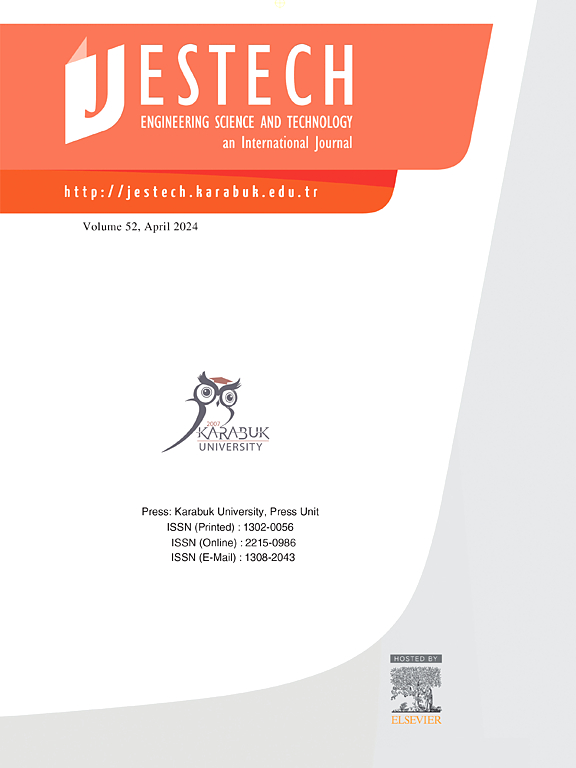X-SmartPlus与6:1对角机头在根管成形过程中非对称往复根管系统的力-扭矩和运动分析
IF 5.4
2区 工程技术
Q1 ENGINEERING, MULTIDISCIPLINARY
Engineering Science and Technology-An International Journal-Jestech
Pub Date : 2025-07-09
DOI:10.1016/j.jestch.2025.102122
引用次数: 0
摘要
比较非对称往复系统在模拟弯曲根管不同区域的运动分析,并测量往复系统对不同模拟根管的受力和扭矩值。设计了定制化的数据采集单元和目标对象。专家在不同类型的模拟根管上的实践表现被记录下来。对弯曲根管进行了管内运动分析。运动运动学数据采用Kruskal-Wallis进行统计分析,然后采用Dwass-Steel-Critchlow-Fligner或单向方差分析,然后采用Tukey检验(p <;0.05)。值得注意的是,虽然马达继续往复运动,但在模拟根管的顶端三分之一没有发生反向扭矩。j型椭圆横截面模拟根管的扭矩和力分布图与其他3种弯曲模拟根管不同。在中位数净循环角和啮合速度(p <;0.05)。主要是管内运动学受操作影响,在按厂家说明书操作的情况下,锉尖在尖端处没有反向旋转。本文章由计算机程序翻译,如有差异,请以英文原文为准。
Force-torque and motion analysis of asymmetrical reciprocating endodontic system during canal shaping procedure with the X-SmartPlus and 6:1 contra-angle handpiece
To investigate motion analysis of an asymmetrical reciprocating system at different regions of a simulated curved canal comparatively, and to measure force and torque values on various simulated root canals by a reciprocating system. A customized data acquisition unit and target object were designed. An expert’s hands-on performance was recorded on various types of simulated root canals. In-the-canal motion analysis was detailed on curved canal. Data on motion kinematics were statistically analyzed with Kruskal-Wallis, followed by the Dwass-Steel-Critchlow-Fligner or one-way ANOVA, followed by a Tukey test where applicable (p < 0.05). Remarkably, no reverse torque occurred in the apical third of simulated root canals, although the motor continued reciprocation. Torque and force plot pattern of the J-type ellipse cross-sectional simulated root canals differed from the other three types of curved simulated root canals. A significant difference was observed in the median net cycle angles and engaging speeds (p < 0.05). Mainly, in-the-canal kinematics were affected by operation, and the tip of file did not rotate in the reverse direction at apex when manufacturer’s instructions were followed.
求助全文
通过发布文献求助,成功后即可免费获取论文全文。
去求助
来源期刊

Engineering Science and Technology-An International Journal-Jestech
Materials Science-Electronic, Optical and Magnetic Materials
CiteScore
11.20
自引率
3.50%
发文量
153
审稿时长
22 days
期刊介绍:
Engineering Science and Technology, an International Journal (JESTECH) (formerly Technology), a peer-reviewed quarterly engineering journal, publishes both theoretical and experimental high quality papers of permanent interest, not previously published in journals, in the field of engineering and applied science which aims to promote the theory and practice of technology and engineering. In addition to peer-reviewed original research papers, the Editorial Board welcomes original research reports, state-of-the-art reviews and communications in the broadly defined field of engineering science and technology.
The scope of JESTECH includes a wide spectrum of subjects including:
-Electrical/Electronics and Computer Engineering (Biomedical Engineering and Instrumentation; Coding, Cryptography, and Information Protection; Communications, Networks, Mobile Computing and Distributed Systems; Compilers and Operating Systems; Computer Architecture, Parallel Processing, and Dependability; Computer Vision and Robotics; Control Theory; Electromagnetic Waves, Microwave Techniques and Antennas; Embedded Systems; Integrated Circuits, VLSI Design, Testing, and CAD; Microelectromechanical Systems; Microelectronics, and Electronic Devices and Circuits; Power, Energy and Energy Conversion Systems; Signal, Image, and Speech Processing)
-Mechanical and Civil Engineering (Automotive Technologies; Biomechanics; Construction Materials; Design and Manufacturing; Dynamics and Control; Energy Generation, Utilization, Conversion, and Storage; Fluid Mechanics and Hydraulics; Heat and Mass Transfer; Micro-Nano Sciences; Renewable and Sustainable Energy Technologies; Robotics and Mechatronics; Solid Mechanics and Structure; Thermal Sciences)
-Metallurgical and Materials Engineering (Advanced Materials Science; Biomaterials; Ceramic and Inorgnanic Materials; Electronic-Magnetic Materials; Energy and Environment; Materials Characterizastion; Metallurgy; Polymers and Nanocomposites)
 求助内容:
求助内容: 应助结果提醒方式:
应助结果提醒方式:


